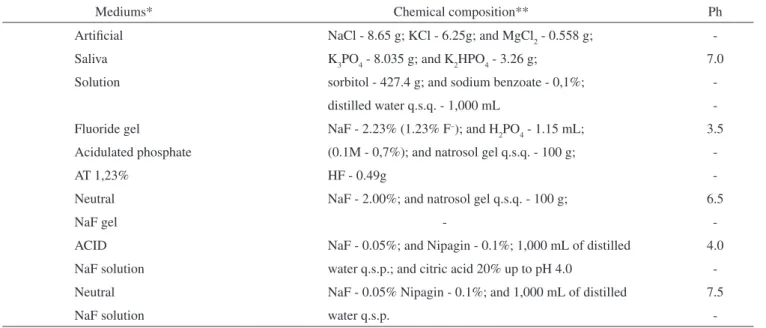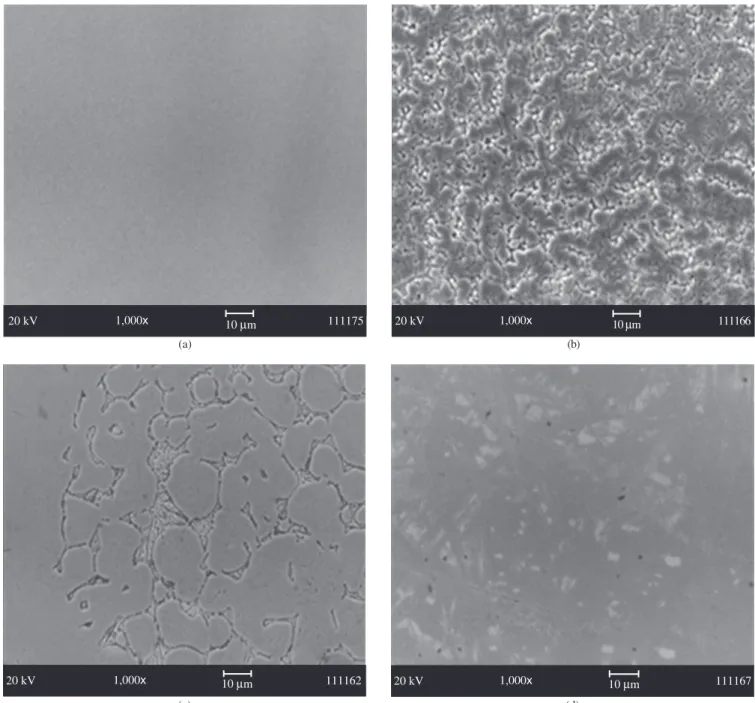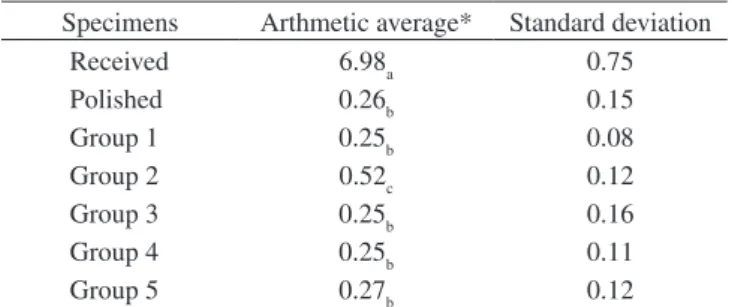Materials Research, Vol. 12, No. 2, 229-232, 2009 © 2009
ride dental solution, by means of an analysis of superficial rugosity. In addition, scanning electron microscopy (SEM) was employed to observe the surface morphology after the test.
2. Materials and Methods
2.1. Specimen preparation and test solutions
Cylindrical specimen (20 mm x 5 mm, n = 5) consisting of commercially pure titanium ASTM®/grade 2 (Ti2 – Dentaurum
J.P. Winkelstroeter KG- Pforzheim, Germany) were casted in the Rematitan system (Rematitan, Dentaurum J.P. Winkerstroeter KG, Pforzheim, Germany) by Vaiazzi Dental Laboratory (São Paulo - SP, Brazil). All specimens were cold mounted with epoxy resin and then received the standard metallography procedure for titanium. The specimens were mechanically polished on wet SiC paper grade 100-1000 (Strues, Denmark), and on successively finer grades of diamond paste 6, 3 and 1 µm (Strues, Denmark). Exposed surface areas of the specimens were 90 to 100 mm2. They were then degreased in ethanol
and rinsed with distilled water. The polished surfaces were examined by optical microscopy (BX600, Olympus®) before fluoride attack.
All test solutions were prepared by Mil Fórmulas pharmacy (Rio de Janeiro - RJ, Brazil). The specimens (n = 5) were divided into 5 groups (one for each group) of different tested solutions: Group 1) synthetic saliva with pH 7.0 (control); Group 2) 1.23% acidulated phosphate fluoride (APF) gel with pH 3.5; Group 3) 2% NaF gel with pH 6.5; Group 4) 0.05% NaF solution with pH 4.0; and Group 5) 0.05% NaF solution with pH 7.5. The specimens were exposed to these solutions for 16 minutes. To simulate an intra oral condition, after attack the specimens were immersed in synthetic saliva waved for 96 hours in magnetic stirrer. The composition of
*e-mail: vivianefbarros@gmail.com
Assessment of Superficial Rugosity of Cast Titanium
in Fluoride Solutions and Artificial Salive
Viviane Fernandes Barrosa*, Mauro Sayão de Mirandaa, José Brant de Camposb
a
Dentistry Faculty, Rio de Janeiro State University,
Av. 28 de setembro, 157, Vila Izabel, 20551-030 Rio de Janeiro - RJ, Brazil
bNational Institute of Technology,
Av. Venezuela, 82, 20081-312 Rio de Janeiro - RJ, Brazil
Received: July 15, 2008; Revised: April 26, 2009
The purpose of this study was to investigate the superficial rugosity of commercially pure titanium cast, under the action of different fluoride dental solutions and synthetic saliva. All specimens received the standard metallography procedure for titanium and were divided in groups: Group 1) synthetic saliva pH 7.0; Group 2) 1.23% APF gel pH 3.5;, Group 3) 2% NaF gel pH 6; Group 4) 0.05% NaF solution pH 4.0; and Group 5) 0.05% NaF solution pH 7.5. The specimens were exposed to these solutions for 16 minutes and immersed in synthetic saliva for 96 hours. The surfaces were analyzed in a roughness device and the results were statistically treated - Snededor ‘F’ and Bonferroni test. In addition, scanning electron microscopy was employed to observe the surface morphology after the test. The Group 2 was the only one which had a significant increase in the superficial roughness. Authors concluded that the fluoride solutions of dental use that have a high concentration of fluoride and low pH are harmful to the surface of cast titanium.
Keywords: titanium, corrosion, fluoride solutions
1. Introduction
Titanium has been developed with distinction in Dentistry, for being a light metal, biocompatible, with low thermal conductivity and excellent resistance to corrosion5. The resistance of metals to corrosion
is directly related mainly to characteristics of their surface and to the medium in which the material is inserted. In relation of titanium, the presence of stable and dense oxide (TiO2) formed on this surface is responsible for its corrosion resistance4,5. Although the oxide layer is not
destroyed under physiological conditions, solutions containing fluoride ions may decrease the resistance to corrosion of titanium3.
In dental treatment, titanium casts are commonly used to manu-facture crowns, bridge frameworks, implant-supported structures, and full and partial denture frameworks with low thermal conductivity4.
The success of dental treatment is dependent on the maintenance of good oral hygiene and cavity control. Fluoride has been used to help the professional in controlling the incidence of new caries and to decrease the dentin sensibility. It has been added to toothpaste, prophylactic agents, and dental rinse. However, a high fluoride concentration used in dental treatment might be harmful to titanium devices such as implants or restorations6,10.
The concern of many researchers has been with the effect of fluoride on titanium. Several authors have reported that titanium is easily degraded while in contact with fluoride acid solutions1-3,7,8,10-12.
Such a phenomenon is interpreted as being a result from incorporation of fluoride ions in the oxide layer, in which the protective properties are the considerably reduced2. The formation of titanium fluoride
oxide leads to many structure defects in such a layer. Furthermore the degradation of the titanium surface may increase the degree of rugos-ity of said surface, favouring the accumulation of bacterial plaque, thus impairing the treatment of restoration as well as the patient’s oral health1. The aim of the present study, in vitro, was to assess the
fluo-230 Barros et al. Materials Research
test solutions used is in “Table 1”. Test solutions were maintained at room temperature.
2.2. Analysis of rugosity and statistic treatment
The assessment of the rugosity of surfaces was performed with the help of a roughness device (SJ-201 P, Mitutoyo®). Such an apparatus
has a kneading tip with 0.005 mm range size which moves at speed of 0.5 mm/min, connected with reading of the surface. The roughness device was duly calibrated according to the instruction guidebook which standardizes the initial reading over a standard surface provided by the manufacturer, in order to thereafter proceed with the subsequent reading of the specimens. A grid with 10 x 10 points was created, where the all specimens (n = 5) were scanned in a 1 cm course. The parameter used was Ra, which registers the average between the peaks and valleys of rugosity in µm.
To compare the rugosity of the specimens as received and of said specimen after being polished, the Student “t” was used. In the com-parison of the polished specimen rugosity with the five attack groups, the Snedecor “F” test was used and when its value was meaningful the Bonferroni test was utilized.
2.3. SEM surface morfology
After the specimens were exposed to solutions, the surfaces were observed under the scanning electron microscopy (Zeiss® DSM 940,
Germany).
3. Results
3.1. Analysis of roughness
• Student“t”testforthespecimenscomparationasreceivedvs. polished. t = 39.26 (p = 0.000) - meaningful at 1% level. • Snedecor“F”testforthespecimenscomparationaspolished
vs. Group 1 vs. Group 2 vs. Group 3 vs. Group 4 vs. Group 5 F = 14.19 (p = 0.000) - meaningful at 1% level. There was a meaningful difference between: Group 2 and polished; Group 2
and Group 1; Group 2 and Group 3; Group 2 and Group 4; Group 2 and Group 5.
3.2. Descriptive analysis of images under SEM
In the analysis performed under SEM different morphological aspects of the titanium surface were observed according to the solu-tion exposed in different groups.
Group 1: A homogeneous surface was observed with no mor-phological aspect characteristic of corrosion (Figure 1a);
Group 2: A totally corroded surface was observed in alls its length, characteristic of a severe and uniform corrosion (Figure 1b);
Group 3: The specimen showed a formation of corrosion micro areas on the surface (Figure 1c); and
Group 4 and 5: The specimens showed a quite similar behavior among them, with generalized formation of pits all over their surface (Figure 1d).
4. Discussion
To Dentistry, the use of the superficial rugosity analysis of restoration materials, both of direct use and of indirect use, is of paramount importance, since an increase in the restoration will be more susceptible to the adherence of bacterial plaque. This could impair the patient’s oral hygiene and health, which may cause the recurrence of cavity lesions and periodontal diseases.
In the present study, the acidulated phosphate fluoride gel entailed a meaningful increase in the superficial rugosity of cast titanium. Nevertheless, in others solutions studied, there was no meaningful difference in the superficial rugosity. Such findings are in accordance with others studies6,11. However Pröbster et al.6 found higher
aver-ages of rugosity both before, in the polished specimen (3.57 µm) as after the attack with the solution (6.19 µm). On the other hand, the arithmetic averages found in the present study for the same type of gel, with attack time of 16 minutes, were of before (0.26 µm, Table 2) and after the attack (0.52 µm, Table 2).
Table 1. Chemical composition and pH of the media used.
Mediums* Chemical composition** Ph
Artificial NaCl - 8.65 g; KCl - 6.25g; and MgCl2 - 0.558 g;
-Saliva K3PO4 - 8.035 g; and K2HPO4 - 3.26 g; 7.0
Solution sorbitol - 427.4 g; and sodium benzoate - 0,1%;
-distilled water q.s.q. - 1,000 mL
-Fluoride gel NaF - 2.23% (1.23% F–); and H
2PO4 - 1.15 mL; 3.5
Acidulated phosphate (0.1M - 0,7%); and natrosol gel q.s.q. - 100 g;
-AT 1,23% HF - 0.49g
-Neutral NaF - 2.00%; and natrosol gel q.s.q. - 100 g; 6.5
NaF gel -
-ACID NaF - 0.05%; and Nipagin - 0.1%; 1,000 mL of distilled 4.0
NaF solution water q.s.p.; and citric acid 20% up to pH 4.0
-Neutral NaF - 0.05% Nipagin - 0.1%; and 1,000 mL of distilled 7.5
NaF solution water q.s.p.
Vol. 12, No. 2, 2009 Assessment of Superficial Rugosity of Cast Titanium in Fluoride Solutions and Artificial Salive 231
verified in the coloring of the surface in contact with the solutions of low fluoride concentration and of neutral gels.
In the present study, the artificial saliva solution chosen was re-garded as control as several authors point out that titanium presents high resistance to corrosion in such a medium7,8.
According to the results of this study, the morphological aspect of titanium surface, when in contact with fluoride ions may vary from the presence of few corrosion pits in localized areas (Figure 1d) to a severe uniform corrosion (Figure 1b), comprising all the surface area of specimens with the destruction of all the oxided titanium film. Such morphological variations in corrosion generated by different fluoride solutions used in this study may be ascribed mainly to the difference of fluoride concentrations of the solutions, as well as to the pH solution which may even have influenced.
When analyzing the surface of the specimens under naked eye, soon after using the acidulated phosphate fluoride gel, a change in its color was observed, which was initially a mirrored metallic brilliant color. After the immersion, the specimen showed a grayish color with total loss of brilliance and there was a drastic increase in the gray shade with new uses of the gel. Such a discoloring was observed by the other authors3,12. Lausmaa et al.3 suggest that the acceleration of
the corrosion products, caused by the attack of fluoride on the accel-eration of the corrosion products, caused by the attack of fluoride on the titanium surface, entails the discoloring of the surface. However, Horasawa and Marek2 verified through a color sensor (MCR-A,
MINOLVA) a discoloring of titanium even in the presence of low concentration of fluoride ions resulting from glass ionomer cement. Such results were not found in the preset study and no change was
232 Barros et al. Materials Research
restorations, which may harm its aesthetic as well as its function. Such patients shall be instructed so as to avoid fluoride solutions, mainly those of high concentration, as well as dentist surgeons shall be more criterious as regard the use of topic applications of gels with high fluoride concentration.
5. Conclusions
The acidulated phosphate fluoride gel entailed a meaningful increase in the rugosity on the surface of the cast titanium, yet the other solutions tested did not show a meaningful difference in the superficial rugosity.
References
1. Harzer W, Schröter A, Gedrange T, Muschter F. Sensitivity of titanium brackets to the corrosive influence of fluoride-containing toothpaste and tea. Angle Orthodontist. 2001; 71(4):318-323.
2. Horasawa N, Marek M. Effect of fluoride from glass ionomer on discoloration and corrosion of titanium. Journal of Dental Research. 2001; 80:546.
3. Lausmaa J, Kasemo B, Hansson S. Accelerated oxide growth on titanium implants during autoclaving caused by fluorine contamination.
Biomaterials. 1985; 6(1):23-28.
4. Meyer JM, Lüthy H. Titan in der Zahnheilkunde- Welche Entwicklung glbt es bis heute? Quintessenz Zahntechv. 1995; 21:681-712.
5. Parr GR, Gardner LK, Toth RW. Titanium: the mystery metal of implant dentistry. Dental materials aspects. The Journal of Prosthetic Dentistry. 1995; 54(3):410-414.
6. Pröbster L, Lin W, Hüttemann H. Effect of fluoride prophylactic agents on titanium surfaces. The International Journal of Oral Maxillofacial Implants. 1992; 7(3):390-394.
7. Reclaru L, Meyer JM. Effects of fluorides on titanium and other dental alloys in dentistry. Biomaterials. 1998; 19(1-3):85-92.
8. Schiff N, Grosgogeat B, Lissac M, Dalard F. Influence of fluoride content and pH on the corrosion resistance of titanium and its alloys. Biomaterials.
2002; 23(9):1995-2002.
9. Strietzel R, Hösch A, Kalbfleisch H, Buch D. In vitro corrosion of titanium. Biomaterials.1998; 19(16):1495-1499.
10. Toumelin-Chemia F, Rouelle F, Burdairon G. Corrosive properties of fluoride-containing odontologic gels against titanium. Journal of Dentistry. 1996; 24(1-2):109-115.
11. Watanabe I, Watanabe E. Surface changes induced by fluoride prophylactic agents on titanium-based orthodontic wires. American Journal of Orthodontics and Dentofacial Orthopedics.2003; 123(6):653-656.
12. Wiig P, Ellingsen JE, Videm K. Corrosion of titanium by fluoride. Journal of Dental Research. 1993; 72:195.
Table 2. Arithmetic average and standard deviation of the values of rugosity obtained from the specimens: as received, polished and in different attack groups.
Specimens Arthmetic average* Standard deviation
Received 6.98a 0.75
Polished 0.26b 0.15
Group 1 0.25b 0.08
Group 2 0.52c 0.12
Group 3 0.25b 0.16
Group 4 0.25b 0.11
Group 5 0.27b 0.12
*Same letters mean similar values.
The fluoride solutions chosen for test medium in such a study regarding the concentration of fluoride and pH of said solutions are most commonly used in Dentistry. Yet, instead of using ready solu-tions available on the market, which present varied manufacturing dates as well as some unknown time on shelves, which may entail a reduction in the concentration shown on labels, we have opted for solutions compounded in pharmacies, especially for the research, preservative and sent free solutions and with fluoride concentrations and pH under control, which provides the study with a standardiza-tion, thus reducing the risk of undesirable variables.
The sixteen minutes time used in this study is equivalent to sixteen applications or rinses with fluoride solutions. As regard rinses, this would correspond to an interval in time of sixteen days, consider-ing that patient would only have a rinse a day. As regard the gel of professional use, it would correspond to a much longer period of time, considering that, at least, such applications would be repeated weekly, being either monthly or with as even longer interval in time. In the literature studied, the time of contact of titanium with the fluoride solutions varies from minutes6 up to weeks2,9 of specimens
in immersion in the attack medium.


